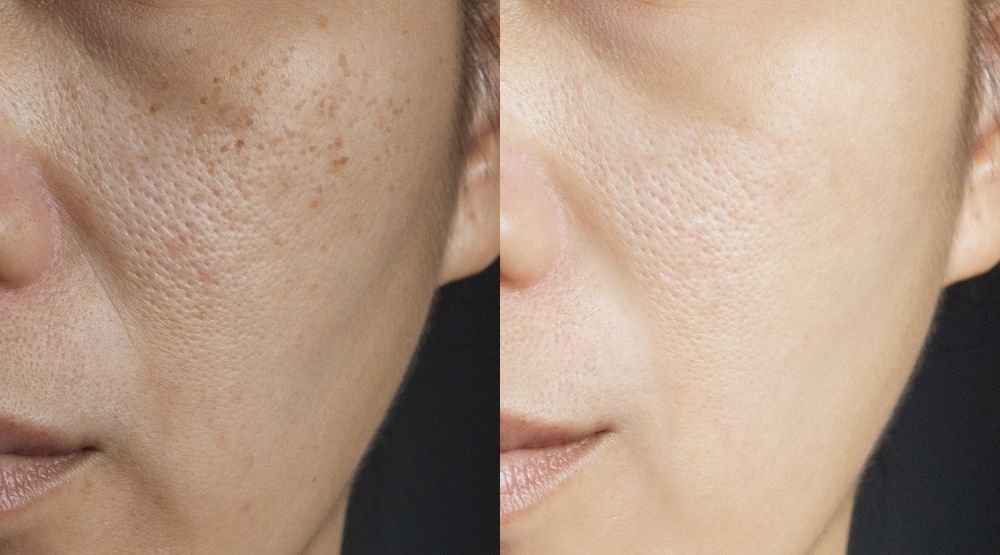Hyperpigmentation is one of the fastest-growing categories of interest for skincare consumers. Market Insights Reports project that the global hyperpigmentation treatment market will accelerate to a compound annual growth rate of 8.3%, reaching $667.4 million by 2027. There are on average 272, 3000 monthly searches for “hyperpigmentation” in the United States alone.
It’s a skincare concern the professional beauty industry would be wise to cater to. But, while there are effective preventative treatments like antioxidants Vitamin C and Niacinamide and Retinol, hyperpigmentation from hormonal fluctuations (such as melasma during or following pregnancy) or sun damage can be hard to remove entirely with topical treatments. In this environment hydroquinone, long considered the gold standard for hyperpigmentation treatment, but shrouded in controversy, is experiencing something of a renaissance. Indeed, according to Google trends, Australian searches of Hydroquinone reached an all-time high in October 2021 (before petering off with the onset of summer).
Given it’s likely your salon clients will be asking about this ingredient, what do you need to know about it? We spoke to Chroma Dermatologies’ Dr. Michelle Rodrgigues, a Dermatologist and specialist in the area of pigmentary disorders, about what makes this ingredient so effective, and how to advise your clients on its usage.
Firstly, how does hydroquinone function as a skin active?
“Hydroquinone is a chemical ingredient that lightens skin. It works by inhibiting the effect of the enzyme tyrosinase, which converts DOPA (that’s, dihydroxyphenylalanine) to melanin (pigment) which means it can improve the pigment sitting in the top epidermal layers of the skin. It also affects melanosomes which are cells responsible for the production, storage and transport of melanin.”
What conditions does hydroquinone work best for?
“Hydroquinone is the current gold standard treatment for some forms of hyperpigmentation. It works best for conditions like freckles, superficial melasma and postinflammatory hyperpigmentation.”

Could you talk us through some of the reputational damage hydroquinone has incurred over the last few decades?
“Hydroquinone as an ingredient has been banned as an over-the-counter preparation in some countries, due to concerns of carcinogenesis (causing cancer) and ochronosis (contradictory blue-black pigmentation that can occur from overuse of hydroquinone)”
“However, the risk of carcinogenesis has not been seen in any scientific studies. Research, including the use of topical hydroquinone cream, did not show any increased risk of cancer at all! Furthermore, traces of hydroquinone are actually found in food and beverages we consume every day, like coffee and berries. The risk of ochronosis is usually seen when people use hydroquinone for prolonged periods of time and when used in high concentrations. If used under the supervision of a dermatologist, this side effect is very rare.”
“Dermatologists who specialise in pigmentary disorders like myself use hydroquinone-based preparations routinely to improve conditions like melasma and post-inflammatory hyperpigmentation. The key is knowing what concentrations, formulas and duration of treatment is needed for each individual. Very low concentrations are unlikely to improve hyperpigmentation while too high a concentration can cause skin irritation and other adverse effects.”
What is the regulatory status of hydroquinone in Australia?
“Over-the-counter hydroquinone is available in concentrations of 2% or less in Australia. Concentrations above this require a prescription from a medical practitioner and need to be made up by a compounding chemist.”
Why do you think hydroquinone has experienced something of a renaissance in recent years?
“People see before and after pictures on Instagram and hear dermatologists debunk the myths during their medical consultation and see articles just like this that separate fact from fiction. In an age of information, as long as the correct sources are found, people will eventually learn that for certain conditions, hydroquinone is still the gold standard treatment.”
For a beauty therapist, if a client is currently using skincare products with hydroquinone, are there any treatments or at home skincare actives they should avoid recommending (and what should they recommend instead?!)
“Hydroquinone should always be combined with a broad spectrum SPF50 sunscreen. The pairing of other ingredients really depends on the person’s skin type and colour, the
condition being treated and even the time of the year.
“Retinoids, topical antioxidants and other tyrosinase inhibitors can also be combined with hydroquinone for improved effect. But the biggest trap is the other ingredients (called excipients) that are often found in over-the-counter hydroquinone formulas. The excipients are often the cause of the redness, irritation, burning and stinging. Combining too many ingredients also increases the risk of side effects on the skin.”
Are there any contraindications for Hydroquinone use?
“Hydroquinone should not be used on broken skin or if there has been an allergy to the ingredient in the past. It cannot be used in pregnancy or whilst breastfeeding as safety data of its use in such cases has not been studied yet.”

Where should hydroquinone sit in a skincare routine? Is there any specific advice that will help clients make the most of this ingredient?
“I don’t believe that hydroquinone should be part of a daily skincare routine. It really needs to be used for a specific reason and to treat a specific condition. Hydroquinone is best applied once daily at night. Over-the-counter hydroquinone (2%), should be used for no longer than 8-12 weeks. After this, if there is no improvement or if ongoing use is needed, consult your general practitioner or dermatologist. It is also important to ensure you wear a good, broad-spectrum sunscreen with SPF factor 50+ every day and reapply it as per the instructions because this protects against worsening hyperpigmentation and increases the effectiveness of the hydroquinone.”
“Unless specifically recommended by your treating doctor, other ingredients should not be
mixed with hydroquinone. It should be washed off thoroughly in the morning. The most important thing with any form of hyperpigmentation is to get the correct diagnosis first because the diagnosis will direct the correct treatment course.”
For those who do not want, or are unable to use hydroquinone in their skincare routine – what alternative actives or professional treatments would you suggest?
“For those who are pregnant or breastfeeding, or those who have a true allergy to hydroquinone, I will often suggest azelaic acid in place of hydroquinone. It is also an effective ingredient for hyperpigmentation and is easy to find and use. But, it does take a number of months to really start to work.”
“Depending on the cause of the hyperpigmentation, in-clinic skin peels can be helpful but people will need to understand that ongoing skin peels will be needed to maintain results. It is equally important not to make hyperpigmentation worse. Caution should be used with laser devices as these can worsen many forms of hyperpigmentation. Picosecond laser devices may be helpful for some forms of treatment-resistant hyperpigmentation but needs to be used by skilled laser providers who have an intimate knowledge and understanding of tissue endpoints. Skin needling and micro-needling has no benefit in most forms of hyperpigmentation and often worsens conditions like melasma.”
Key points to keep in mind:
. Don’t overcomplicate a skincare routine if your client has been prescribed hydroquinone
. Hydroquinone can cause skin irritation, redness, itching and skin allergy
. Hydroquinone should not be used while pregnant or breastfeeding and should not be applied on areas of broken skin
. Aggressive treatments are unlikely to work for hyperpigmentation. Some forms of lasers are not appropriate and treatments like microneedling are unlikely to be effective. If your client is unable to use hydroquinone but wants to reduce their hyperpigmentation consider treatments like Picosecond laser or topicals like azelaic acid.
Want more?
Follow Chroma Dermatology on Instagram
Check out more ingredients focused explainers like our Vitamin C myth-busting interview with Dr Cara McDonald.
Read the current issue of our digital magazine here:
- For more news and updates, subscribe to our weekly newsletter
- Follow us on Instagram
- Like us on Facebook
- Join Australia’s largest network of beauty industry professionals on LinkedIn
- Subscribe to our print magazine
Have an idea for a story or want to see a topic covered on our site and in our pages? Get in touch at info@professionalbeauty.com.au.

